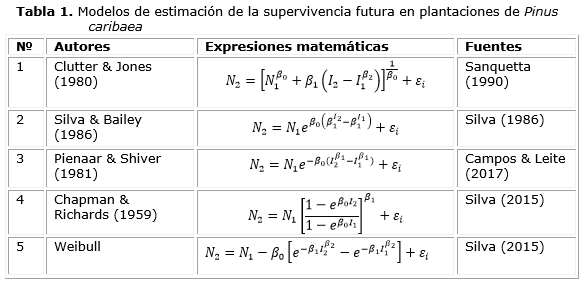Survival prognosis in plantations of Pinus caribaea Morelet var. caribaea Barrett & Golfari
Main Article Content
Abstract
Downloads
Article Details
References
ALEIXO DA SILVA, J.A., 2015. Conceitos e princípios básicos de modelagem matemática em ciências florestais. Anais da Academia Pernambucana de Ciência Agronômica, vol. 11/12, pp. 195-215.
BIGLER, C. y BUGMANN, H., 2003. Growth-dependent tree mortality models based on tree rings. Canadian Journal of Forest Research, vol. 33 (2), pp. 210-221. DOI www.nrcresearchpress.com/doi/pdf/10.1139/x02-180.
BUCHMAN, R.G., PEDERSON, S.P. y WALTERS, N.R., 1983. A tree survival model with application to species of the Great Lakes region. Canadian Journal of Forest Research, vol. 13, pp. 601-608.
CAMPOS, J.C.C. y LEITE, H.G., 2017. Mensuração florestal: perguntas e respostas. 5a ed. S.l.: Viçosa: Editora UFV.
CHAPMAN, D.., 1961. Statistical problems in population dynamics. Proceedings of the fourth Berkeley symposium on mathematical statistics and probability. USA: Berkeley, CA, University of California Press, pp. 153-186.
CLUTTER, J.L. et al., 1983. Timber management: a quantitative approach [en línea]. 1sted. New York: John Wiley & Sons, 1983. Disponible en: https://www.amazon.com/Timber-Management-Quantitative-Jerome-Clutter/dp/0894647474
CLUTTER, J.L. y JONES, E.., 1980. Prediction of growth after thinning in old-field slash pine plantation [en línea]. S.l.: Res. Pap. SE-217. Asheville, NC: U.S. Dept. of Agriculture, Forest Service, Southeastern Forest Experiment Station. Disponible en: http://agris.fao.org/agris-search/search.do?recordID=US8044500
GLOVER, G.. y HOLL, J.., 1979. A basal area ratio predictor of loblolly pine plantation mortality. Forest Science, vol. 25 (2), pp. 275-282.
GUAN, BIING, T. y GERTNER, G., 1991. Modeling red pine tree survival with an artificial neural network. Forest Science, vol. 37 (5), pp. 14291440.
HAMILTON, D.A., 1974. Event probabilities estimated by regression [en línea]. INT-152. Utah, USA: USDA Forest Service, Intermountain Forest and Range Experiment Station, Ogden, Utah. Research Paper. Disponible en: https://www.biodiversitylibrary.org/bibliography/68708#/summary , https://doi.org/10.5962/bhl.title.68708 , https://www.biodiversitylibrary.org/bibliography/68708#/details.
HAMILTON, D.A., 1986. A logistic model of mortality in thinned and unthinned mixed conifer stands of Northern Idaho. Forest Science, vol. 32 (4), pp. 9891000.
HANN, D.W., 1980. Development and evaluation of an even- and uneven-aged ponderosa pine [en línea]. Arizona, USA: Arizona Fescue stand simulator. Ogden: Forest Service/Intermountain Forest and Range Experiment Station. Disponible en: https://archive.org/details/developmentevalu267hann.
K VANCLAY, J., 1994. Modelling forest growth and yield/ : applications to mixed tropical forests [en línea]. S.l.: Wallingford: CAB International UK. Disponible en: https://epubs.scu.edu.au/cgi/viewcontent.cgi?article=1538&context=esm_pubs.
L KING, S., BENNETT, K.P. y LIST, S., 2000. Modelling non-catastrophic individual tree mortality using logistic regression, neural networks, and support vector methods. Computers and Electronics in Agriculture, vol. 27, pp. 401-406.
LEE, Y., 1971. Predicting mortality for even-aged stands of lodgepole pine. Forestry Chronicle, vol. 47(1), pp. 29-32.
LORIMER, C.G., DAHIR, S.. y NORDHEIM, E.., 2001. Tree mortality and longevity in mature and old-growth hemlockhardwood forests. Journal of Ecology, vol. 89, pp. 960-971. DOI http://www.nrcresearchpress.com/doi/abs/10.1139/X10-14.
MALEKI, K. y KIVISTE, A., 2016. Individual tree mortality of silver birch (Betula pendula Roth) in Estonia. iForest, vol. 9, pp. 643-651.
PIENAAR, L.V. y SHIVER, B.D., 1981. Survival functions for site prepared slash pine plantations in the flat woods of Georgia Northern Florida. Southern Jour. Forestry, vol. 5 (2), pp. 59-62.
RICHARDS, F.J., 1959. A flexible growth function for empirical use. Journal of Experimental Botany, vol. 10, pp. 290-300.
SANQUETTA, C.R., 1990. Predição da sobrevivência em reflorestamentos de Pinus elliottii Engelm [en línea]. Tesis de Maestría para la obtención del título de Máster en Ingeniería Forestal. Brasil, Curitiba: Universidade Federal do Paraná. Disponible en: https://www.bdpa.cnptia.embrapa.br/consulta/busca?b=ad&id=305301&biblioteca=vazio&busca=autoria:%
SANQUETTA,%20%20C.%20R.%22&qFacets=autoria:%22SANQUETTA,%20%20C.%20R.%22&sort=&paginacao=t&paginaAtual=1.
SILVA, J.A.A. DA, 1986. Dynamics of stand structure in fertilized slash pine plantations [en línea]. Georgia Athens, USA: University of Georgia. Disponible en: https://books.google.com.cu/books/about/Dynamics_of_Stand_Structure_in_Fertilize.html?id=6Y5TNwAACAAJ&redir_esc=y.
VANCLAY, J.K., 1991. Mortality functions for north Queensland rain forests. Journal of Tropical Forest Science, vol. 4 (1), pp. 15-36.


